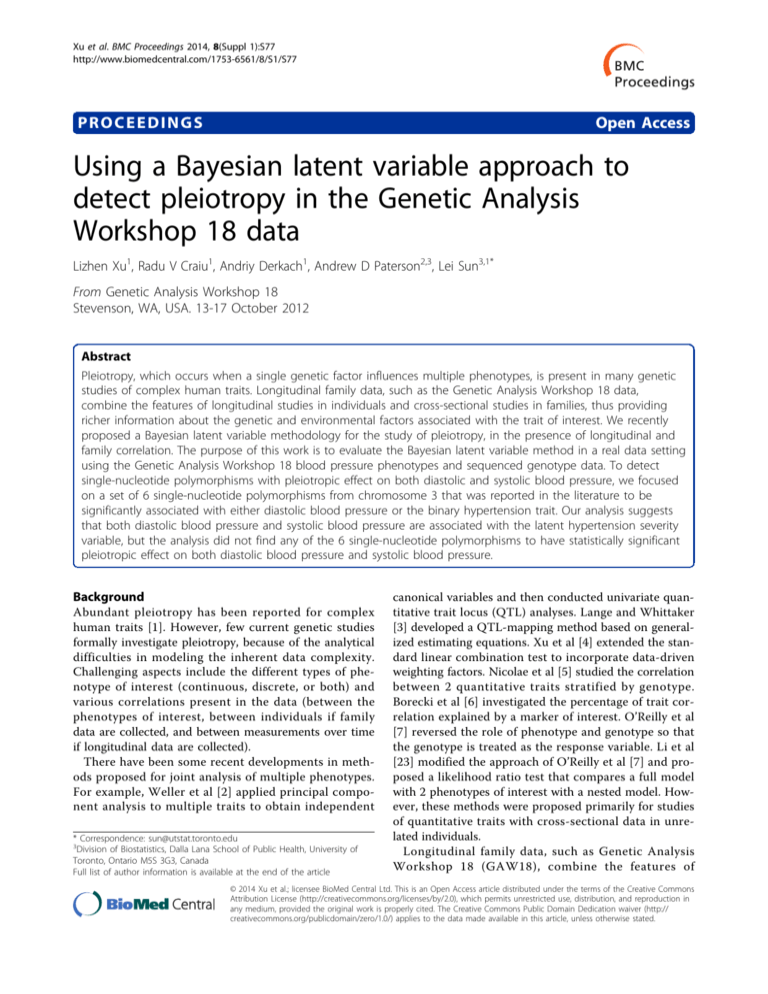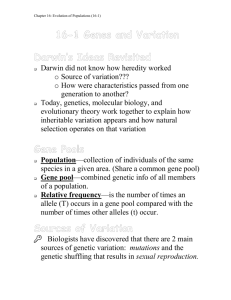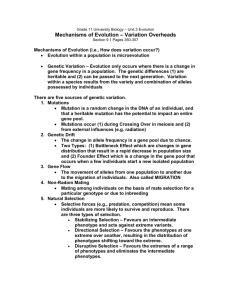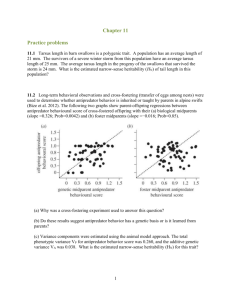Using a Bayesian latent variable approach to detect pleiotropy in the
advertisement

Xu et al. BMC Proceedings 2014, 8(Suppl 1):S77
http://www.biomedcentral.com/1753-6561/8/S1/S77
PROCEEDINGS
Open Access
Using a Bayesian latent variable approach to
detect pleiotropy in the Genetic Analysis
Workshop 18 data
Lizhen Xu1, Radu V Craiu1, Andriy Derkach1, Andrew D Paterson2,3, Lei Sun3,1*
From Genetic Analysis Workshop 18
Stevenson, WA, USA. 13-17 October 2012
Abstract
Pleiotropy, which occurs when a single genetic factor influences multiple phenotypes, is present in many genetic
studies of complex human traits. Longitudinal family data, such as the Genetic Analysis Workshop 18 data,
combine the features of longitudinal studies in individuals and cross-sectional studies in families, thus providing
richer information about the genetic and environmental factors associated with the trait of interest. We recently
proposed a Bayesian latent variable methodology for the study of pleiotropy, in the presence of longitudinal and
family correlation. The purpose of this work is to evaluate the Bayesian latent variable method in a real data setting
using the Genetic Analysis Workshop 18 blood pressure phenotypes and sequenced genotype data. To detect
single-nucleotide polymorphisms with pleiotropic effect on both diastolic and systolic blood pressure, we focused
on a set of 6 single-nucleotide polymorphisms from chromosome 3 that was reported in the literature to be
significantly associated with either diastolic blood pressure or the binary hypertension trait. Our analysis suggests
that both diastolic blood pressure and systolic blood pressure are associated with the latent hypertension severity
variable, but the analysis did not find any of the 6 single-nucleotide polymorphisms to have statistically significant
pleiotropic effect on both diastolic blood pressure and systolic blood pressure.
Background
Abundant pleiotropy has been reported for complex
human traits [1]. However, few current genetic studies
formally investigate pleiotropy, because of the analytical
difficulties in modeling the inherent data complexity.
Challenging aspects include the different types of phenotype of interest (continuous, discrete, or both) and
various correlations present in the data (between the
phenotypes of interest, between individuals if family
data are collected, and between measurements over time
if longitudinal data are collected).
There have been some recent developments in methods proposed for joint analysis of multiple phenotypes.
For example, Weller et al [2] applied principal component analysis to multiple traits to obtain independent
* Correspondence: sun@utstat.toronto.edu
3
Division of Biostatistics, Dalla Lana School of Public Health, University of
Toronto, Ontario M5S 3G3, Canada
Full list of author information is available at the end of the article
canonical variables and then conducted univariate quantitative trait locus (QTL) analyses. Lange and Whittaker
[3] developed a QTL-mapping method based on generalized estimating equations. Xu et al [4] extended the standard linear combination test to incorporate data-driven
weighting factors. Nicolae et al [5] studied the correlation
between 2 quantitative traits stratified by genotype.
Borecki et al [6] investigated the percentage of trait correlation explained by a marker of interest. O’Reilly et al
[7] reversed the role of phenotype and genotype so that
the genotype is treated as the response variable. Li et al
[23] modified the approach of O’Reilly et al [7] and proposed a likelihood ratio test that compares a full model
with 2 phenotypes of interest with a nested model. However, these methods were proposed primarily for studies
of quantitative traits with cross-sectional data in unrelated individuals.
Longitudinal family data, such as Genetic Analysis
Workshop 18 (GAW18), combine the features of
© 2014 Xu et al.; licensee BioMed Central Ltd. This is an Open Access article distributed under the terms of the Creative Commons
Attribution License (http://creativecommons.org/licenses/by/2.0), which permits unrestricted use, distribution, and reproduction in
any medium, provided the original work is properly cited. The Creative Commons Public Domain Dedication waiver (http://
creativecommons.org/publicdomain/zero/1.0/) applies to the data made available in this article, unless otherwise stated.
Xu et al. BMC Proceedings 2014, 8(Suppl 1):S77
http://www.biomedcentral.com/1753-6561/8/S1/S77
longitudinal studies in independent individuals and studies using families. Therefore, they provide more information about the genetic and environmental factors
associated with the trait of interest than cross-sectional
studies [8]. However, joint modeling of multiple phenotypes using longitudinal family data involves nontrivial
analytical challenges because of the complex phenotypic,
familial, and serial correlations.
We recently proposed to use the latent variable (LV)
methodology for study of pleiotropy, in the presence of
longitudinal and family correlation [9]. The LV methodology has been widely used in many scientific fields,
including economics, psychology, and social sciences,
and it is becoming increasingly attractive for genetic studies. For example, Ohara et al [10] proposed a LV
approach for the analysis of multivariate quantitative trait
loci; Tayo et al [11] applied a factor analysis (a subtype of
the LV model [LVM]) to find latent common genetic
components of obesity traits; and Nock et al [12] used
factor analysis for a metabolic syndrome study. Initial
applications of LVM focused on reducing the number of
manifest variables to a smaller number of latent outcomes. Sammel and Ryan [13,14] extended the LVM to
allow covariates to have effects on both the manifest and
LVs. Roy and Lin [15] discussed a LV approach for longitudinal data with continuous outcomes. Xu et al [9]
extended the work of Roy and Lin [15] to accommodate
both binary and continuous phenotypes and family data,
and proposed a Bayesian approach for parameter estimation. The focus of this work is to evaluate the Bayesian
LV method of Xu et al [9] in a real data setting using the
GAW18 blood pressure phenotype data and sequenced
genotype data.
Methods
The latent variable model
Here we briefly review the LV methodology proposed by
Xu et al [9]. The formulation of the LVM relies on postulating the effect of a random variable that is not
observed by the researchers but is assumed to play an
important role in various observed variables (also
known as the manifest variables), and thus induces correlations among them [16]. In the context of pleiotropy
studies, the manifest variables are the multiple observed
phenotypes, which inform the LV that represents the
underlying conceptual disease status or severity. The
proposed LVM consists of 2 parts. The first part models
the relationship between the manifest variables (Y s) and
the LV (U) to characterize the within-subject correlation
among different outcomes. The second part uses a linear
mixed-effect model to investigate the effect of a genetic
marker and other covariates (X s) on the LV (U),
accounting for the longitudinal and familial correlations.
Page 2 of 5
Formally, let Ycit = (ycit1 , . . . , ycitJ ) be the J × 1 vector
of responses (eg, phenotypes) measured at the tth time
on the ith individual from the cth family (or cluster) for
i = 1, 2, . . . , Nc, i = 1, 2, . . . , Nc, t = 1, 2, . . . , Tci, where C
denotes the total number of families, Nc is the number
of individuals within the cth family, Tci is the total number of repeated measurements for the individual {c, i}
and J is the total number of responses. Among the J
c
c
c
= (ycit1
, · · · , ycitJ
) are the continuous
responses, Ycit
1
b
b
b responses and Ycit = (ycitJ1 +1 , · · · , ycitJ
) are the binary
responses. Let Ucit be the LV representing the conceptual disease severity, which summarizes the partial information brought by each of the J phenotypes.
The first part of the LVM models the relationship
between the phenotypes (Ys) and the LV (U) to characterize the within-subject correlation among the different
outcomes. A continuous phenotype is linked to the
latent trait Ucit via a linear mixed model
c
T
ycitj
= β0j + Wcit
βj + λj Ucit + bcij + ecitj
(2:1)
iid
where ecitj ∼ N(0, σj2 ), Wcit is a p1-dimensional vector
of direct effect covariates, β0j is the mean effect of phenotype j, and λj is the factor loading that represents the
effect of the LV on the phenotype. The random component bcij captures the family-specific within-subject coriid
relations over time. We assume bcij ∼ N(0, τj2 ), and ecitj
and bcij are mutually independent. If a phenotype is binary, a generalized linear mixed model,
T
ηcitj = β0j + Wcit
βj + λj Ucit + ecitj
(2:2)
is assumed with a probit link,
b
b
E[ycitj
|Ucit , bcij ] = p(ycitj
= 1|Ucit , bcij ) = (ηcitj )
(2:3)
We choose a probit link instead of a logit link to gain
computational efficiency.
The second part of the LVM models the influence of
indirect covariates on the LV via the linear mixed
model,
T
Ucit = Xcit
α + ac + dci + εcit
(2:4)
iid
where cit ∼
N(0, 1), ac and dci are the random effects
to model correlations of the LV U cit among subjects
within a family and the dependency between repeated
measures of Ucit, with ac ∼ N(0, σa2 ), and dci ∼ N(0, σd2 ).
X cit is a p 2 -dimensional vector of covariates that can
include both environmental and genetic factors, and a is
the corresponding vector of regression parameters characterizing the association between the LV (U) and X.
This set of covariates influences the phenotypes through
its impact on the LV (U) and is often of the primary
Xu et al. BMC Proceedings 2014, 8(Suppl 1):S77
http://www.biomedcentral.com/1753-6561/8/S1/S77
interest. Particularly, if a single-nucleotide polymorphism (SNP) included in X is found to be statistically associated with U, the SNP is deemed to be pleiotropic. For
the purpose of model identification, we assume that the
2 sets of covariates X and W are disjoint.
Parameter estimation via Bayesian method
Xu et al [9] considered a Bayesian estimation for the
LVM parameters to allow a principled approach to incorporate prior information, which can be substantial in
many practical genetic studies, and to produce finite
sample likelihood-based inference. The data in the proposed LVM contain the observed continuous and binary
outcomes Y, the covariates W with direct effect on Y, and
the covariates X with indirect effect on Y via U. The parameter of interest is = (β0 , β, α, λ, τ 2 , σ 2 , σa2 , σd2 ) where
β = (β1 , . . . , βJ ), β = (β1 , . . . , βJ ), βj = (βj1 , . . . , βjp1 )
λ = (λ1 , . . . , λJ ), λ = (λ1 , . . . , λJ ), τ 2 = (τ12 , · · · , τJ2 ) and
σ 2 = (σ12 , · · · , σJ21 ). The posterior distribution for the
model parameters is: p(|Y, W, X) ∝ P()p(Y|, W, X)
Markov chain Monte Carlo (MCMC) algorithms are used
to draw posterior samples for statistical inference. In
addition, the data augmentation principle of Tanner and
Wong [17] and the parameter expansion and hierarchical
centering techniques of Gelfand [18], Liu and Wu [19],
and Meng and van Dyk [20] are applied to speed up the
MCMC’s mixing. Uninformative conjugate priors are
given to the parameters in the expanded model. Bayes
factors (BFs) calculated using the path sampling method
are used to test the significance of factor loadings and the
fixed effects. The support for the alternative hypothesis of
pleiotropy is detected if log BF > 0.5 [9].
Data analysis
The phenotypes of interest are diastolic blood pressure
(DBP) and systolic blood pressure (SBP). We considered
464 individuals from the 16 families (Type 2 Diabetes
Genetic Exploration by Next-generation sequencing in
Ethnic Samples [T2D-GENES] Project 2) that were
sequenced. Among the 464 individuals, 396 individuals
have at least 1 blood pressure measure (90 have only 1, 78
have 2, 131 have 3, and 97 have 4 measurements). The
length of time between 2 consecutive measurements
ranges from 3 to 9 years, and the number of family members varies from 11 to 36. For the phenotypes of interest,
we added a value of 15 to SBP and a value of 10 to DBP
for those individuals who took antihypertensive medication [21]. Among the available covariates–age, sex, antihypertensive medications, and tobacco smoking status–we
included age and sex in our analysis.
To detect SNPs with pleiotropy effect, we focused on a
set of 6 SNPs from chromosome 3 (rs9816772, rs9852991,
rs6768438, rs9815354, rs7640747 and rs743395) that had
Page 3 of 5
been reported to be significantly associated with either
DBP or the binary hypertension trait, based on a largescale genome-wide association study of blood pressure
and hypertension under an additive genetic model
assumption [22]. Table 1 summarizes the results that were
reported in Levy et al [22]. It shows that 4 SNPs
(rs9816772, rs9852991, rs6768438, and rs9815354) were
found to be significantly associated with DBP but not with
SBP nor with the binary hypertension trait. Note that the
4 SNPs are near the gene ULK4, close to each other, and
likely to be in strong linkage disequilibrium (LD). Therefore their statistical association results are expected to be
similar. The other 2 SNPs (rs7640747 and rs743395) were
found to be significantly associated with hypertension, but
only suggestively with SBP or DBP. These 2 SNPs are also
close to each other in high LD and near ITGA9.
We then applied the Bayesian LVM method to analyze
1 SNP at a time, assuming an additive genetic model.
For each SNP of interest, the phenotypes Ys are SBP
and DBP, the covariates include the genotype of the
SNP, age, and sex, and the continuous LV U represents
the conceptual hypertension severity level. We began
our analysis by considering all possible models that
include the 3 covariates, where each covariate has either
direct effects on the phenotypes Ys or indirect effect
through U. Table 2 gives the deviance information criteria statistics of these models and model 5 (covariate
Sex is included in Equation (2.1) with direct effect on
the phenotypes and Age and SNP in Equation (2.4) with
indirect effect on the phenotypes via the LV) has smallest deviance information criteria (DIC) value. Thus, we
used model 5 to fit the data. We then applied the BF
method to further determine whether the effects of
these chosen covariates are statistical significant. The
folded-t prior with 3 degrees of freedom is used for λj,
Np1 (0, Ip1 ) is used for βj, and Np2 (0, Ip2 ) is used for a.
For comparison, we also report the highest posterior
density interval (HpdI) for testing the factor loadings
and the fixed effects.
Table 1 Genome-wide association result for the 6 SNPs
reported by Levy et al [22]
p Values
SNP
Gene
MAF
DBP
−7
SBP
Hypertension
rs9816772
ULK4
0.16
9.7 × 10
0.5
0.85
rs9852991
rs6768438
ULK4
ULK4
0.16
0.16
9.7 × 10−7
9.7 × 10−7
0.59
0.59
0.85
0.84
rs9815354
ULK4
0.17
7.8 × 10−7
0.69
0.83
rs7640747
ITGA9
0.38
9.5 × 10−4
5.9 × 10−4
4.8 × 10−7
rs743395
ITGA9
0.38
4.4 × 10−4
8.0 × 10−4
7.5 × 10−7
In the GAW18 data analyzed, the minor allele frequency (MAF) for these SNPs
are 0.15, 0.13, 0.18, 0.13, 0.30, 0.29, respectively.
Xu et al. BMC Proceedings 2014, 8(Suppl 1):S77
http://www.biomedcentral.com/1753-6561/8/S1/S77
Page 4 of 5
Table 2 Goodness-of-fit statistics for alternative latent variable models applied to rs9816772
Model
Covariates
With phenotypes Y s in Equation (2.1)
DIC
With latent variable U in Equation (2.4)
1
Age+sex+SNP
N/A
15388.7
2
Age+sex
SNP
15729.3
3
Age+SNP
Sex
15746.5
4
Sex+SNP
Age
15820.6
5
Sex
Age+SNP
15226.5
6
SNP
Age+sex
15247.9
7
8
Age
N/A
Sex+SNP
Age+sex+SNP
15744.0
15948.3
DIC, deviance information criteria.
Results
Based on the results shown in Table 3, both SBP and
DBP are associated with the latent hypertension severity
variable with the factor loading for SBP being 13.15 and
for DBP being 7.60, which are all significantly larger
than zero. Furthermore, the sizes of the 2 factor loadings suggest that the strength of the relationship
between SBP and the LV is about 1.7 times greater than
that between DBP and the LV. Sex shows no significant
association with SBP, with the logarithm of Bayes factor
(logBF) being negative, and the 95% HpdI covering zero.
However, it has significant negative effect on DBP, indicating that females have lower DBP than males. Age
appears to have a significant positive effect on the
underlying hypertension severity variable with logBF
equaling 126.53. There is no evidence that rs9816772 is
significantly associated with the LV, with the logBF
being less than zero and the 95% HpdI for a1, the coefficient for the SNP, covering zero. Results for other
SNPs are characteristically similar to what’s reported
here for rs9816772. Therefore, our analysis did not
detect a pleiotropy effect on both DBP and SBP for any
of the 6 SNPs that were previously reported to be associated with DBP or the binary hypertension trait.
Table 3 Results of the Bayesian LV method applied to
rs9816772, previously identified as associated with DBP
SBP
DBP
Sex for SBP
Sex for DBP
rs9816772
Age
Parameter
Estimate
logBF
95% HpdI
λ1
λ2
β11
β21
α1
α2
13.15
7.60
255.3
139.6
(12.19, 14.11)
(7.01, 8.14)
−0.66
−0.074
(−2.12, 0.81)
−1.79
2.017
(−2.92, -0.65)
−0.045
−0.653
(−0.208, 0.124)
0.043
126.53
(0.036, 0.049)
λj is the factor loading for the association between phenotype Yj (j = 1, 2:
SBP and DBP) and the conceptual latent variable U, βjk evaluates the
association between phenotype Yj and covariate Wk( k = 1: sex), αk captures
the association between the latent variable U and covariate Xk (k = 1, 2: SNP
and age).
Discussion and conclusions
In this paper, we investigated the Bayesian LV methodology recently proposed by our group to joint model
multiple phenotypes, in the presence of serial and familial correlations [9]. The proposed method provides a
conceptually easy but effective way to jointly study multiple correlated phenotypes, which could be a mixture of
continuous and binary outcomes with serial and familial
correlations. These multiple outcomes are assumed to
be related to a LV, which can be interpreted as the
latent disease severity. As a by-product of our MCMC
algorithm, the method provides subject-specific estimate
of the LV, which can be used for further analysis. The
2-level modeling scheme allows us to estimate and test
the global effects of the covariates on the multiple outcomes, which are more efficient than the traditionally
used multiple tests [15].
We applied this method to the GAW18 data, jointly
analysing SBP and DBP. A LV U is introduced to characterize the within-subject correlation between the 2
phenotypes and can be interpreted as the underlying
hypertension severity variable. Pleiotropy is detected if a
genetic marker is found to have a significant effect on
U. To detect SNPs with pleiotropic effect on SBP and
DBP, we investigated a set of 6 SNPs from chromosome
3 that were previously shown to be significantly associated with either DBP or the hypertension trait. However, we did not see statistically significance evidence for
pleiotropy effect for any of the 6 SNPs.
The incorporation of family-specific random effect ac
in equation (2.4) allows us to model the familial correlation of the underlying disease trait. However, this formulation does not take into account the different
degrees of genetic relationship among the individuals
within a family. Thus, alternative models incorporating
the kinship matrix will be considered in the future. Our
future work also includes developing alternative models
that adjust for the unequally spaced time measurements,
and more efficient algorithms so that a genome-wide
search for pleiotropic SNPs can be performed. (The
Xu et al. BMC Proceedings 2014, 8(Suppl 1):S77
http://www.biomedcentral.com/1753-6561/8/S1/S77
current computation time is about 1.7 minutes per
SNP.) Evaluating the performance of the Bayesian LVM
method using the simulated data, and extension of the
method to joint analysis of multiple rare variants are
also of interest.
Page 5 of 5
9.
10.
11.
12.
Competing interests
The authors declare that they have no competing interests.
Authors’ contributions
Study design: LX, RVC, ADP, and LS. Analysis: LX and AD. Manuscript
drafting: LX and LS. All authors read and approved the final manuscript.
13.
Acknowledgements
This work was supported by the Natural Sciences and Engineering Research
Council of Canada (NSERC) to LS, NSERC to VRC, the Canadian Institutes of
Health Research (CIHR) to VRC and LS, the Ontario Graduate Scholarship
(OGS) to LX, and the OGS and the CIHR Strategic Training for Advanced
Genetic Epidemiology (STAGE) fellowship to AD, University of Toronto. ADP
holds a Canada Research Chair in the Genetics of Complex Diseases.
The GAW18 whole genome sequence data were provided by the T2DGENES Consortium, which is supported by NIH grants U01 DK085524, U01
DK085584, U01 DK085501, U01 DK085526, and U01 DK085545. The other
genetic and phenotypic data for GAW18 were provided by the San Antonio
Family Heart Study and San Antonio Family Diabetes/Gallbladder Study,
which are supported by NIH grants P01 HL045222, R01 DK047482, and R01
DK053889. The Genetic Analysis Workshop is supported by NIH grant R01
GM031575.
This article has been published as part of BMC Proceedings Volume 8
Supplement 1, 2014: Genetic Analysis Workshop 18. The full contents of the
supplement are available online at http://www.biomedcentral.com/bmcproc/
supplements/8/S1. Publication charges for this supplement were funded by
the Texas Biomedical Research Institute.
15.
Authors’ details
Department of Statistical Sciences, University of Toronto, Toronto, Ontario
M5S 3G3, Canada. 2Program in Genetics and Genome Biology, The Hospital
for Sick Children, Toronto M5G 1X8, Canada. 3Division of Biostatistics, Dalla
Lana School of Public Health, University of Toronto, Ontario M5S 3G3,
Canada.
1
14.
16.
17.
18.
19.
20.
21.
22.
23.
Xu L, Craiu V, Sun L, Paterson A: Bayesian latent variable modelling of
longitudinal family data for genetic pleiotropy studies. Cornell University
Library; 2012, arXiv:1211.1405 [stat.AP].
O’Hara RB, Komulainen P, Savolainen O, Sillanpää MJ: A latent variable
approach to multivariate quantitative trait loci. Nature Precedings 2010
[http://hdl.handle.net/10101/npre.2010.4137.1], Available from.
Tayo B, Harders R, Luke A, Zhu X, Cooper R: Latent common genetic
components of obesity traits. Int J Obes (Lond) 2008, 32:1799-1806.
Nock NL, Wang X, Thompson CL, Song Y, Baechle D, Raska P, Stein CM,
Gray-McGuirel C: Defining genetic determinants of the metabolic
syndrome in the Framingham Heart Study using association and
structural equation modeling methods. BMC Proc 2009, 3(Suppl 7):S50.
Sammel MD, Ryan LM: Latent variable models with fixed effects.
Biometrics 1996, 52:650-663.
Sammel MD, Ryan LM: Latent variable models for mixed discrete and
continuous outcomes. J R Stat Soc Series B Stat Methodol 1997, 59:667-678.
Roy J, Lin X: Latent variable models for longitudinal data with multiple
continuous outcomes. Biometrics 2000, 56:1047-1054.
Bartholomew D, Knott M, Moustaki I: Latent Variable Models and Factor
Analysis: A Unified Approach. Wiley Series in Probability and Statistics.John
Wiley & Sons;, 3 2011.
Tanner M, Wong W: The calculation of posterior distributions by data
augmentation. J Am Stat Assoc 1987, 82:528-540.
Gelfand AE: Efficient parametrisations for normal linear mixed models.
Biometrika 1995, 82:479-488.
Liu JS, Wu YN: Parameter expansion for data augmentation. J Am Stat
Assoc 1999, 94:1264-1274.
Meng X-L, van Dyk D: Seeking efficient data augmentation schemes via
conditional and marginal augmentation. Biometrika 1999, 86:301-320.
Tobin MD, Sheehan NA, Scurrah KJ, Burton PR: Latent common genetic
components of obesity traits. Stat Med 2005, 24:2911-2935.
Levy D, Ehret GB, Rice K, Verwoert GC, Launer LJ, Dehghan A, Glazer NL,
Morrison AC, Johnson AD, Aspelund T, et al: Genome-wide association
study of blood pressure and hypertension. Nat Genet 2009, 41:677-687.
Li W, Soave D, Miller MR, Keenan K, Fan L, Gong J, Chiang T,
Stephenson AL, Durie P, Rommens J, Sun L, Strug LJ: Unraveling the
complex genetic model for cystic fibrosis: pleiotropic effects of modifier
genes on early cystic fibrosis-related morbidities. Hum Genet 2103 [http://
www.ncbi.nlm.nih.gov/pubmed/24057835], Epub ahead of print.
doi:10.1186/1753-6561-8-S1-S77
Cite this article as: Xu et al.: Using a Bayesian latent variable approach
to detect pleiotropy in the Genetic Analysis Workshop 18 data. BMC
Proceedings 2014 8(Suppl 1):S77.
Published: 17 June 2014
References
1. Sivakumaran S, Agakov F, Theodoratou E, Prendergast JG, Zgaga L,
Manolio T, Rudan I, McKeigue P, Wilson JF, Campbell H: Abundant
pleiotropy in human complex diseases and traits. Am J Hum Genet 2011,
89:607-618.
2. Weller JI, Wiggans GR, VanRaden PM, Ron M: Application of canonical
transformation to detection of quantitative trait loci with the aid of
genetic markers in a multitrait experiment. Theor Appl Genet 1996,
92:998-1002.
3. Lange C, Whittaker JC: Mapping quantitative trait loci using generalized
estimating equations. Genetics 2001, 159:1325-1337.
4. Xu X, Lu T, Wei LJ: Combining dependent tests for linkage or association
across multiple phenotypic traits. Biostatistics 2003, 4:223-229.
5. Nicolae D, Kistner E, Cox N: Testing for pleiotropy in quantitative traits
using data from genome-wide association studies. The 59th annual
meeting of the American Society of Human Genetics, Honolulu, HI USA;
2009, Abstract number 181. October 20-24.
6. Borecki I, Zhang Q, Province M: Detection and dissection of pleiotropy for
complex multivariate traits. The annual meeting of the International
Genetic Epidemiology Society; 2011, Abstract number 19.
7. O’Reilly PF, Hoggart CJ, Pomyen Y, Calboli PFC, Elliott P, Jarvelin MR,
Coin LJ: Multiphen: joint model of multiple phenotypes can increases
discovery in GWAS. PLoS One 2012, 7:e34861.
8. Burton P, Scurrah K, Tobin MD, Palmer L: Covariance components models
for longitudinal family data. Int J Epidemiol 2005, 34:1063-1067.
Submit your next manuscript to BioMed Central
and take full advantage of:
• Convenient online submission
• Thorough peer review
• No space constraints or color figure charges
• Immediate publication on acceptance
• Inclusion in PubMed, CAS, Scopus and Google Scholar
• Research which is freely available for redistribution
Submit your manuscript at
www.biomedcentral.com/submit




![[CLICK HERE AND TYPE TITLE]](http://s3.studylib.net/store/data/006606986_1-782c3ecb8a70372ce425cead2575d909-300x300.png)




